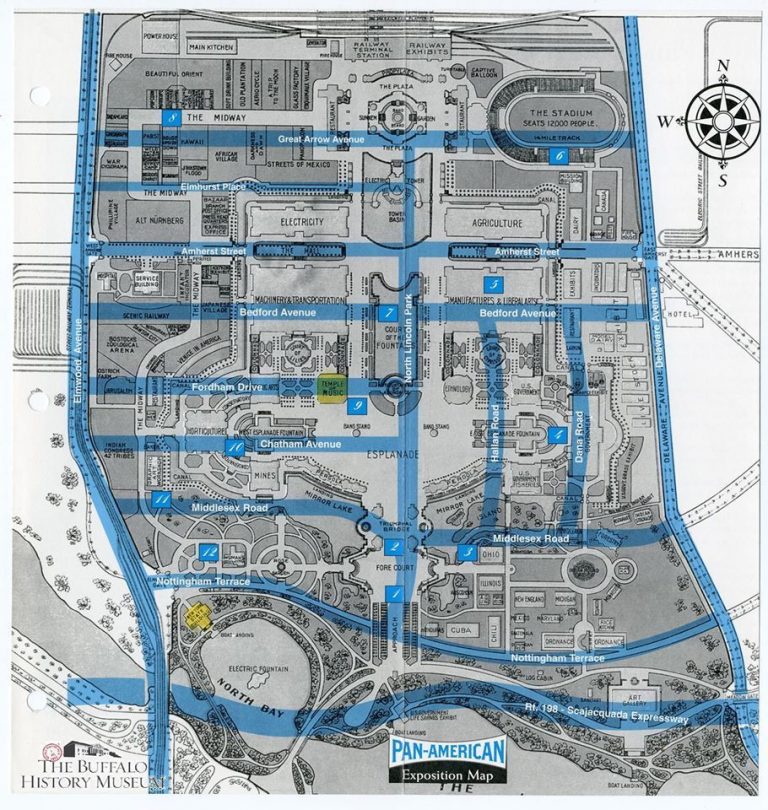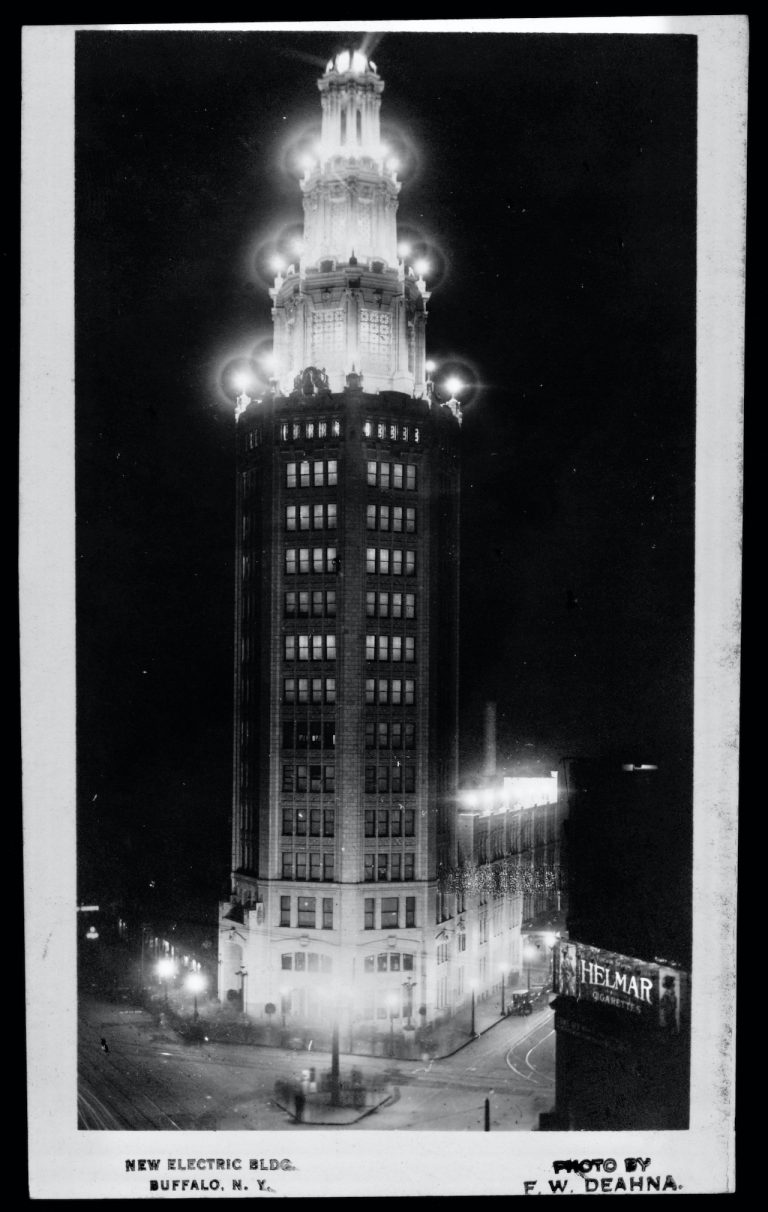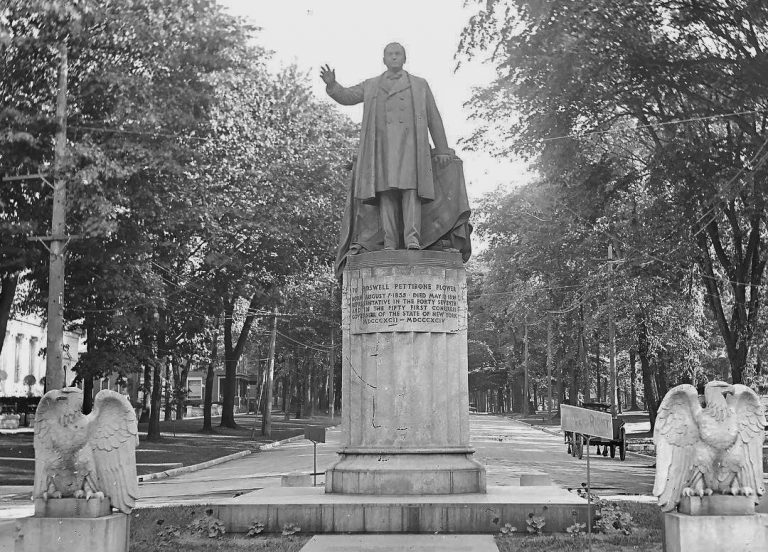The Howard Electric Tower at the 1901 Pan-American Exposition In Buffalo, NY
Roughly four years in the making, the 1901 Pan American Exposition’s crown jewel was the Howard Electric Tower. Designed by John Galen Howard, the mammoth tower was a marvel and its design would go on to inspire the smaller, yet equally captivating Electric Tower that debuted in Coney Island’s Luna Park in 1903 as well as the General Electric Building in Buffalo which was constructed 10 years after the Exposition in 1911 and completed in 1912.
Initially to be held on Cayuga Island due to its close proximity to the large tourist attraction of Niagara Falls, it would be delayed and ultimately moved to the city of Buffalo. Once the decision was made, the Pan-American Exposition Company began planning at the western edge of Delaware Park for what would amount to be a 350-acre design for the event which ran from May 2 through November 2nd.
Today, the area that comprises where the Exposition was held is located between Elmwood Avenue and Delaware Avenue from east to west and just north of Great Arrow Avenue to the Scajaquada Expressway to the south (see Buffalo History Museum map in gallery.)
Though Niagara Falls failed in its bid to host the exposition, it played an important role in the Exposition by generating power that lit up the entire exposition and the Howard Electric Tower’s base had water flowing through it. The Howard Electric Tower was also equipped with a giant spotlight that was used to signal back and forth to Niagara Falls during the Exposition.
Pan-American Exposition By Night:
Porter, E. S., White, J. H., Smith, J. B., Thomas A. Edison, I. & Paper Print Collection. (1901) Pan-American Exposition by night. United States: Thomas A. Edison, Inc. [Video] Retrieved from the Library of Congress.
The plans for the Howard Electric Tower would be revealed in the February 10, 1900 edition of the Buffalo News who reported—
This magnificent steel structure is to stand on a commanding elevation at the north end of the Court of Fountains.Its base will be semi-circular in form, and will be 265 by 195 feet in dimension.The base will consist of arch-forming columns which will rise to a height of 71 feet.
On top of these columns will be a promenade.In front of the tower, partly enclosed by the semi-circular foundation, will be an immense basin of water, with one great splashing fountain, which at night will be beautifully illuminated with white and colored electric-lights.
The second landing above the ground will be 200 feet high, the third 253 feet and the fourth 292.The distance to the ground to the extreme top of the great tower will be 350 feet.In other words, this sky-piercing structure will be more than twice as high as the Prudential building.

Also in preparation for the Exposition were entrepreneurs and showmen Frederic Thompson and Elmer “Skip” Bundy who were competing against each other for a Midway ride initially designed by Thompson. Bundy would beat him to the punch with a variation of Thompson’s “Darkness and Dawn” installation. Having witnessed the many spectacles at the Exposition, including the Howard Electric Tower, the two would join forces and create Luna Park at Coney Island featuring their own Electric Tower.

The Buffalo News would write of the Howard Electric Tower in its May 1, 1900 edition–
The splendid structure, 376 feet high of ivory and gold, accented with green, is the first object seen on approaching the Exposition and the last one upon leaving it. At its top stands the golden “Goddess of Light’ by Herbert Adams. In its various niches are the groups of “The Great Waters in the Days of the Indians” and the “Great Waters in the days of the White Man” of Barnard. The splendid figures, “Niagara” and “Buffalo,” by Welnmann and “St. Lawrence” and “St. Clair,” by Neihaus, and the seated figures representing the Great Lakes.”
From the principal niche at its base is to pour a torrent of water which will flow down over sculptured cascades and expand into large basin which will reflect the Beatles of the tower. The principal niche emits a flood of 1300 gallons of water each minute. On each side of the center of the tower 26 large pillar jets throw the water 50 feet into the air, and 42 large jets in the center throw the Watertown back toward the cascades. It was the most beautiful of all the beauty spots of the Exposition.
The Assassination of President McKinley
While there was much to celebrate during the 1901 Pan-American Exposition in Buffalo, unfortunately what it is most remembered for is the assassination of the 25th President of the United States of America, William McKinley. President McKinley was shot twice in the abdomen on September 6th, only six months into his second term my anarchist Leon Czolgosz while at the Exposition’s Temple of Music.
In a twist of ironic tragedy, doctors were reluctant to utilize the newly developed x-ray machine showcased at the Exposition for fear of its uncertain effects it may have. Furthermore, the emergency hospital at the Exposition lacked electrical lighting, despite its buildings covered and draped in tens of thousands of lightbulbs, the giant spotlight atop the Howard Electric Tower and the advent of the alternating current power transmission being celebrated and showcased with electricity as a theme.
Showing initial signs of recovery, President McKinley’s wounds developed gangrene one September 13th. He would pass away the following morning, the third President to die of assassination behind Abraham Lincoln and James Garfield. The day prior to the shooting, President McKinley’s speech addressed the Exposition’s importance, stating—
Expositions are the timekeepers of progress. They record the world’s advancement. They stimulate the energy, enterprise, and intellect of the people; and quicken human genius. They go into the home. They broaden and brighten the daily life of the people. They open mighty storehouses of information to the student.
All Good Things Must Come To An End
An estimated 8,000,000 people visited the 1901 Pan-American Exposition in Buffalo, witnessing its many sights and sounds including that of the Howard Electrical Tower. The expense tallied with inflation, in 2021 dollars, would be nearly $220,000,000.
In early March of 1902, just a few short months after the Exposition ended, demolition would begin on the vast majority of the buildings constructed for the Exposition, including the Howard Electric Tower. The structure designated as the New York State Building on the bank of water in Delaware Park still stands today as the Buffalo History Museum.
While demolition would take nearly an entire year, in President McKinley’s words, the Exposition has served justly in its recordings as “timekeepers of progress.” Sometimes it takes a trip down memory lane to remind us of the things that once were. And as the memories of older generations fade, it’s up to newer generations to shine a light upon the past to see how far we’ve come.

















